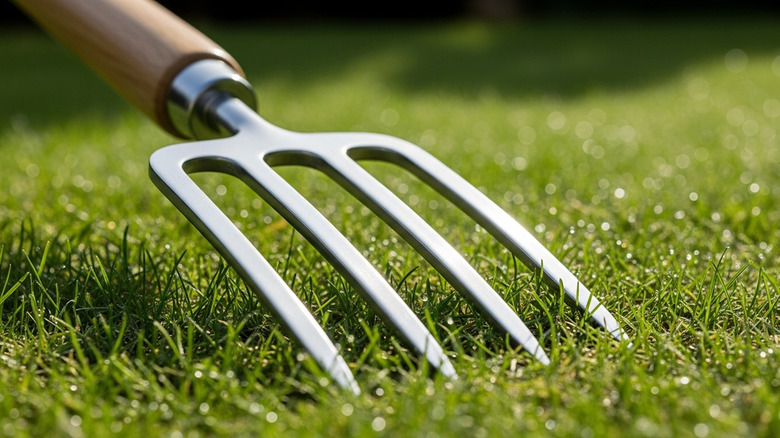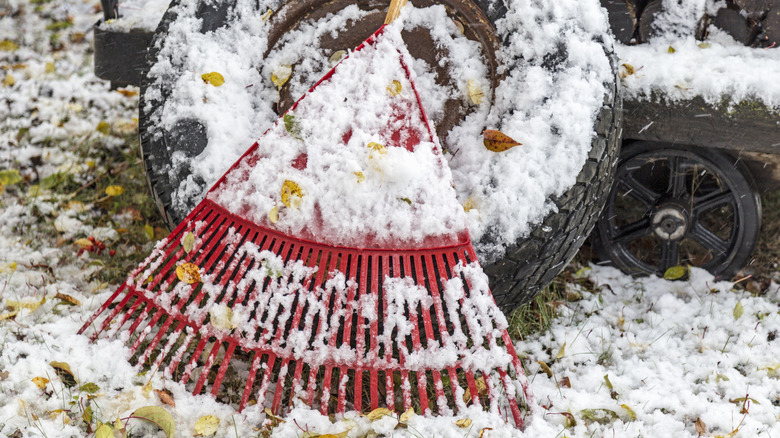4 Snow & Ice Removal Tools That Are Hiding In Your Garden Shed
If you live in an area with erratic weather patterns, chances are you may have already gotten caught in a snowstorm or two so far this season. You may not have even had the chance to dig out all of your winter tools and gear just yet, leaving you stranded with a snow-caked sidewalk and frozen car windshields. Before you panic about retrieving your ice scraper, shovels, and ice melt, you may, in fact, want to check out your garden shed first. Everything you need is already inside, including your garden fork, your standard shovel, and even that bottle of vinegar you've been using to clean your gardening tools.
Maybe you've found yourself unprepared for the winter weather, or maybe you want to save some cash this year by utilizing your gardening tools for the ice and snow. Either way, you can make use of these basic gardening tools during more than just the summertime.
Shovel
No snow shovel available? No problem. While a snow shovel is built to withstand large amounts of snow, your standard garden shovel is a fine substitute if you don't have the latter on hand and if the snow isn't too heavy. While it certainly won't be quite as effective, it can do in a pinch to help dig out your front door, sidewalk, driveway, or car from the fallen snow. If you live in an area that doesn't get heavy snow, there's no need to purchase a snow shovel if you already have a smaller gardening version at home.
Since these types of tools are usually made with tempered or carbon steel, make sure to be cautious and avoid scratching or damaging your doors, car, or driveway. You might also want to be careful, as standard shovels are typically heavier than their snow counterparts, and can potentially cause injuries if you strain to pick up dense snow. If your shovel is dull from use over the summer, sharpen it up using a hand file or an angle grinder.
Garden fork
Ice can be so difficult to remove that it feels like concrete, making it a challenging material to break without the proper tools. But if you're dealing with pesky packed snow or ice spots, and you're having trouble breaking it apart, a garden fork might actually come in handy. You know, that small tool you use to move and transplant plants and seedlings? Yes, any size should do. Since garden forks are typically made of high-strength carbon steel or stainless steel, their durability is an excellent asset when it comes to digging out ice.
You can insert the fork deep into the packed snow or ice. Usually, a forceful jab or two will get the fork underneath the ice, and the tines of the fork should make it easy for you to pry the ice piece out. You don't need a fancy ice pick to get the job done.
Rake
If you have any type of large gardening tool lying around your home, it's probably a standard garden rake. Even if it's not of the highest quality, a gardening rake can be the perfect makeshift winter tool to help you remove snow and ice from around and on top of your home.
Given their length, rakes are especially useful when it comes to removing snow from the roof of your home. Since you want to avoid using ladders or climbing onto your roof when it's icy and slippery outside, a rake helps you reach those tough parts without having to risk a falling injury. There are "roof rakes" you can purchase, but a regular version from your garage will work just fine. It's recommended to clear your roof of snow every six inches to avoid any buildup. Start with the eaves and the bottom of your roof before working your way up to the top.
Vinegar
If you don't have any rock salt available in your garage or attic, there's no need to panic. You have one more pantry staple that can still save you from the slippery ice and snow outside: a bottle of white vinegar. While not as effective as commercial de-icers, vinegar is a great substitute and can help you dissolve the ice stuck in and around your home. Thanks to the acidic nature of vinegar, this product can de-ice your property, including your driveway and sidewalks.
According to experts, the most effective way to utilize vinegar to get rid of ice is to combine it with hot water. As for the ratio, you can mix equal parts water with vinegar, and increase that ratio to 60% vinegar if the ice is extra thick. Note that vinegar can potentially damage or dull concrete, so if using it on this type of material, use it with caution.




